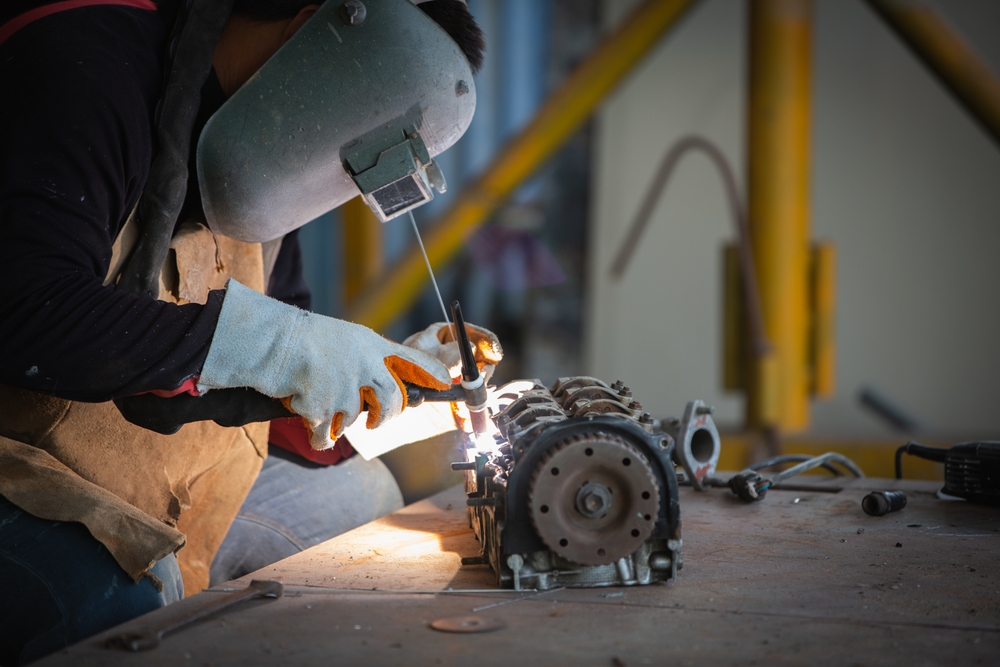Welding is a foundational fabrication process that joins materials, usually metals or thermoplastics, by employing heat to melt parts and fuse them together. It allows manufacturers, fabricators, and repair technicians to create and maintain all kinds of essential equipment, machinery, and infrastructure. While there are many welding methods, one of the most versatile and precise is gas tungsten arc welding (GTAW), also known as tungsten inert gas (TIG) welding.
In this guide, we’ll dive into the key points of GTAW, including the equipment and setup, the welding process itself, and the necessary safety precautions. Whether you’re new to welding or looking to expand your skill set, understanding the fundamentals of GTAW will help you become a more versatile fabricator.
Let’s get started.
Key Points
- GTAW uses a non-consumable tungsten electrode and an inert shielding gas (typically argon or helium) to create strong, clean welds without the need for filler material.
- GTAW is ideal for joining thin metals, exotic alloys, and other materials that require a high degree of control and finesse.
- GTAW requires more skill and precision than some other welding processes, but the results are worth it.
- The technique is widely used in industries like aerospace, automotive, shipbuilding, and more.
What is Gas Tungsten Arc Welding?
Unlike other types of welding methods, GTAW allows the welder to have greater control over the weld, resulting in stronger, higher-quality welds. The process works by using a constant-current welding power supply to generate electrical energy, which is then conducted across the arc through a column of highly ionized gas and metal vapors known as plasma.
While GTAW is more complex and difficult to master compared to some other welding techniques, it offers significant advantages in terms of precision and weld quality. A filler metal is often used, though “autogenous” or “fusion” welds can be created without it.
What Is GTAW Used For?
GTAW welding is particularly well-suited for welding thin materials or those that are electrically resistant and heat up quickly. While it may not be the most effective choice for very thick sheet metal, the high degree of control and precision offered by GTAW makes it an invaluable tool in many industrial and fabrication settings, including:
- Aerospace and space vehicle manufacturing
- Race car fabrication and motorsports
- Ship fitting and marine construction
- Piping, tools, and die production
- Motor vehicle repair and construction
- Bicycle manufacturing and repair
- Other sectors like pharmaceuticals, nuclear, and art
Start Your Welding Career Today!
Kickstart your journey to becoming a skilled welder with our comprehensive program. Master the essential techniques and get certified for a successful career!
Evolution of Gas Tungsten Arc Welding
Arc welding can be traced back to the early 19th century. Over time, as fabrication needs evolved, it became clear that welding non-ferrous materials like aluminum and magnesium would require some sort of shielding to prevent reactions with the air, resulting in porous welds. GTAW was developed in the early 1940s to solve this problem, employing a tungsten electrode arc and helium as the shielding gas. Today, it is often referred to as tungsten inert gas welding (TIG welding) — although the American Welding Society officially recognizes the term gas tungsten arc welding (GTAW).

Evolution of Gas Tungsten Arc Welding
How Does the GTAW Process Work?
At the heart of the GTAW process is the formation of an intense arc between a non-consumable tungsten electrode and the workpiece. This arc produces the heat necessary to melt and fuse the materials being joined. During GTAW, the welder uses a hand-held torch to direct the arc onto the workpiece. An inert shielding gas — typically argon or helium — envelops the weld area to protect it from atmospheric contamination. A filler metal may also be added manually to the weld pool to build up the joint.
The welder has precise control over the electrical current flowing to the weld, often using a foot pedal or other device to modulate the heat input. This level of control is a key advantage of the GTAW process, allowing for exceptionally high-quality, spatter-free welds.
Welding Procedure Variables and Equipment
Gas Tungsten Arc Welding Tungsten Electrodes
Tungsten is the preferred electrode material for GTAW due to its high melting point and excellent electrical conductivity. Alloying the tungsten with other metals can further improve performance for specific applications.
Shielding Gasses in GTAW
Argon is the most common, as it helps prevent defects caused by variations in arc length. Helium can increase penetration and welding speed but is more difficult to strike an arc with.
Power Supply
Even if the arc distance and voltage change, the power supply must have a constant current. Because GTAW is usually performed manually or semi automatically, it relies on constant current power sources to prevent heat variations that can result from constant voltage power sources.
Welding Torch
GTAW torches are designed to be operated manually or automatically. They’re equipped with cooling systems, using either air or water. There are a few different methods that can be used to initiate the arc in a GTAW setup:
- Scratch start: The welder scratches the tungsten electrode on the workpiece to create the arc. This can lead to tungsten contamination.
- Lift start: The welder uses a foot pedal to lift the torch and start the arc in a controlled manner, avoiding direct contact.
- High-frequency start: The most common approach, this method uses a high-voltage, high-frequency circuit to create the arc without any physical contact.
Weld Joint Design
When creating a weld joint, it’s important to consider how strong it needs to be. Weld joints can be partial or full penetration depending on the required strength. For GTAW, the design depends on the type of metal, weldment configuration, codes, and metallurgical analysis. There are many factors to consider when designing a joint, such as the needed strength, welding position, metal thickness, and accessibility for the welder.
The five most common types of joints are:
- Butt joint
- Corner joint
- Edge joint
- Lap joint
- T joint
What Metal is Used in GTAW
GTAW is a versatile process that can be used on a wide range of metals and alloys, including:
- Aluminum: GTAW is often the optimal choice for welding aluminum parts, especially in aerospace, automotive, and other industries that value the material’s lightweight strength.
- Stainless Steel: When welding stainless steel, it’s important to use a DC machine with the electrode as the negative polarity. This provides better control over heat input, minimizes distortion, and preserves the material’s corrosion-resistant properties.
- Carbon and Low-Alloy Steels: GTAW allows for precise control over heat input, producing high-quality, low-spatter welds on various steel grades. It’s commonly used in structural fabrication, piping, and automotive production.
- Chromoly: The crack resistance and strength of gas tungsten arc welds make it the preferred process for chromium-molybdenum alloys used in motorsports, bicycles, and other applications.
- Nickel Alloys: Renowned for their corrosion and high-temperature resistance, nickel alloys are often gas tungsten arc welded using argon, helium, or argon-hydrogen shielding gasses.
How Hard is it to Learn Gas Tungsten Arc Welding?
Overall, the GTAW process requires significant skill and precision from the welder, but the results are well worth it: strong, high-integrity welds across a wide range of materials and applications. Unlike simpler techniques, like shielded metal arc welding (SMAW), GTAW requires a high degree of finesse.
Key reasons why GTAW has a steeper learning curve:
- The need to simultaneously control the welding torch, filler metal addition, and electrical current
- Challenges in striking and maintaining a stable arc with the non-consumable tungsten electrode
- Greater sensitivity to variables like shielding gas flow and arc length
- Overall slower welding speeds compared to other processes
- Many welders will start with more beginner-friendly welding methods before progressing to GTAW. Taking in-person classes from experienced instructors is highly recommended to develop the necessary skills and techniques. With patience and practice, however, GTAW can be mastered, opening up a world of high-quality, precision welding applications.

How Hard is it to Learn Gas Tungsten Arc Welding?
What Safety Precautions Should I Take When Gas Tungsten Arc Welding
As with any welding process, proper safety precautions are critical when performing GTAW. By following established safety protocols and using the proper personal protective equipment, welders can mitigate the risks associated with the GTAW process, including fatal lung diseases like emphysema and oedema.
Key areas of focus include:
- Eye and Skin Protection: The intense ultraviolet light from the GTAW arc can easily lead to “arc eye” (welder’s flash) and severe skin burns if not properly shielded. Welders must wear welding helmets with dark, filter-type lenses as well as protective clothing covering the entire body.
- Ventilation: Though GTAW produces less smoke and fumes than some other welding methods, it’s still important to ensure adequate ventilation to prevent exposure to any metal vapors or shielding gas byproducts.
- Electrical Safety: Proper grounding and insulation of the welding equipment is essential to avoid electric shock hazards. Welders should also be cautious of the hot metal workpieces.
- Fire Prevention: Flammable materials must be cleared from the welding area, and a fire extinguisher should be readily available in case of emergencies.
Start Your Career in an In-Demand Industry
Interested in developing the skills and techniques outlined in this guide? The Erie Institute of Technology provides welding training through our Welding Technology Program.
Upon completion of our welding program, students will understand the common types of welding processes and their applications at foundational, intermediate, and advanced levels. In just 12 months, students can take welding classes and learn valuable skills, including:
- Blueprint reading
- Gas metal arc welding
- Gas tungsten arc welding
- Pipe welding
- Welding fabrication
About Author:

Ross Aresco
CFO
Ross Aresco is the CFO of Erie Institute of Technology. Erie Institute of Technology (EIT) is an Erie Pennsylvania technical/trade school providing training programs for medical, computer, electronics, manufacturing, and technology careers. EIT offers programs in many different areas to suit your interests and talents.
